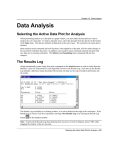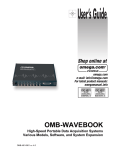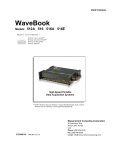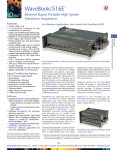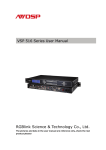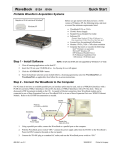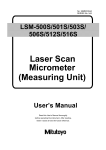Download WBK30
Transcript
WBK30 User's Guide WaveBook Memory Option Reference Note: The WaveBook User's Manual has additional information on buffer operation, data packing, WaveView, custom programming, and related issues. Acquired data Data to PC Memory Controller P1 connects to J101 in WaveBook 8 MB DRAM 8 MB DRAM 8 MB DRAM 8 MB DRAM 8 MB DRAM 8 MB DRAM 8 MB DRAM 8 MB DRAM 8 MB DRAM 8 MB DRAM 8 MB DRAM 8 MB DRAM 8 MB DRAM 8 MB DRAM 8 MB DRAM 8 MB DRAM WBK30 Block Diagram The WBK30 is a DRAM-based memory board that installs inside a WaveBook. The WBK30 increases the capacity of the WaveBook's standard data buffer from 64 thousand samples to 8-64 million samples (increased by a factor of ×125 to ×1000). The WBK30 is available with 3 capacities: • WBK30/16—16.7 MB to hold 8.3 million samples (11.1 million packed) • WBK30/64—67.1 MB to hold 33.5 million samples (44.7 million packed) • WBK30/128—134.2 MB to hold 67.1 million samples (89.4 million packed) Benefits of using the larger and enhanced data buffer include: • Compensates for a PC's slow connection, slow disk-drive, or limited memory. • Prevents data loss when an acquisition is stopped deliberately or due to buffer overflow. The user can stop (disarm) an acquisition at any time. On disarm, data in the WBK30 is preserved and transferred to the PC. • Reduces the PC's CPU load during the pre-trigger acquisition by performing internal buffer management. Note: Without the WBK30, acquired data flows as fast as possible from the WaveBook to the PC. With a WBK30, the transfer can be delayed until the scan is complete. In some cases, this may delay the "real-time" view available in WaveView. Features The WBK30 adds 2 important features to WaveBook operation: • Overflow Protection Mode allows the PC to correctly retrieve all data collected before the overflow. Even with the WBK30's large memory, it can still overflow during a fast acquisition with a slow PC. In such cases, overflow protection can preserve millions of potentially valuable samples. In an overflow condition without this protection, all data in the buffer would be lost. • Pre-Trigger Mode allows local buffering of pre-trigger acquisitions. The WBK30 manages finitelength acquisitions entirely within its own buffer instead of using the PC's resources. During the acquisition, the WaveBook begins acquiring data in advance of the trigger. When the trigger occurs, a specified amount of the most recent "pre-trigger" data is preserved. The "post-trigger" data is then collected as specified. Together, pretrigger data and post-trigger data comprise the entire acquisition. Without a WBK30, all pre-trigger data (including any to be discarded) must be transferred into the PC's memory, followed by the post-trigger data. This data transfer may be impossible if the PC (or its port) is too slow. With the WBK30, all the desired data is kept in the WBK30 buffer until the acquisition is complete. Then, the PC (at its own speed) reads the entire, correct acquisition. Thus, the collection of pre-trigger data can continue indefinitely, even at the highest acquisition rate. Of course, the WBK30 must have the capacity to hold all pre-trigger and post-trigger data. p/n 1025-0901 rev 2.0 (per EO# 2116R3) WBK30 User's Guide 1 Hardware Setup CAUTION Turn power off to all connected devices before performing the setup. To avoid pin damage, make sure the memory card is aligned correctly with the mating connector J101. Gently press them together. Perform the setup in a static-free work area using tools, wrist strap, containers, and procedures that are ESD-safe. One or more components are sensitive to damage from electrostatic discharge. WBK30 Note: The figure shows a WaveBook/512; the /516 is similar. Not all components are shown. P1 Foam Pad Remove 3 jumpers from J101. 262-0303 chip must be stamped "MEM A". If not, an upgrade is required. Card guide on inside of WaveBook/516 front panel WBK30 Connection to a WaveBook Install the WBK30 into a WaveBook as follows: 1. Turn off all system power, and unplug the power adapter from the WaveBook. 2. Remove the WaveBook's top cover plate. 3. Verify compatibility. The WBK30 is compatible with all WaveBook/516s and upgraded WaveBook/512s. To determine /512 compatibility, locate p/n 262-0303 (the FPGA IC) on the WaveBook's motherboard (see figure). The 262-0303 chip must be stamped "MEM A" for the WBK30 to work properly. By serial number, the following WaveBook/512s are not compatible: 148010 and below, 148253, 149322, 150411-150413, 150415, 150418, 151597, 153335. If not compatible, contact the factory about an upgrade. After a WaveBook/512 is modified for the WBK30, it must have a WBK30 to work—to return to operation without the WBK30 would require another factory modification. 4. Remove all 3 jumpers from the WaveBook's 40-pin connector J101. 5. Align the WBK30 so its P1 connector is directly over J101. [In a WaveBook/516, before pressing the connectors together, slip the opposite end of the WBK30 into the plastic card guide above the D-sub connector on the front panel.] Gently press the connectors together—be careful to avoid pin damage. Verify the setting is secure (in the /512, the foam pad helps brace the WBK30 against the top cover plate). 6. Replace top cover plate, and power up the system. 2 WBK30 User's Guide p/n 1025-0901 rev 2.0 (per EO# 2116R3) Software Setup Reference Note: Chapter 5 of the WaveBook User's Manual explains WaveView in greater detail. Chapters 14 and 15 explain programming with the enhanced API. WaveView The WBK30 is supported by WaveView version 7.2 and higher. Check-boxes in the System-Options menu allow you to enable or disable the Pre-Trigger and/or Overflow Protection modes. Both modes will be enabled by default when WaveView first detects the presence of the WBK30. • Enable WBK30 Pre-Trigger Mode — causes WaveView to use the Pre-Trigger Mode for high-speed pre-trigger acquisitions. Acquisitions unable to use the Pre-Trigger Mode will run normally whether this setting is enabled or not. When using the WBK30 pre-trigger mode, the actual number of pretrigger scans acquired may be up to 3 scans less than the pre-trigger scan count programmed in the acquisition configuration dialog. • Enable Overflow Protection Mode — causes WaveView to use the Overflow Protection for all acquisitions. Data is preserved if you cancel a transfer by selecting the STOP button in either the Scope or Direct-to-Disk window. Disable this mode if data from a stopped acquisition is unwanted. DaqX Programming of the WBK30 Only the enhanced API (DaqX versions 2.4 and higher) supports the WBK30. The standard API (with wbk... commands) cannot address the WBK30. Commands affecting the WBK30 include: daqAdcTransferSetBuffer sets information to initialize a data transfer. One argument is a bit mask of transfer-mode codes. • DatmPacingMode – Setting this bit in the transferMask argument enables Pacing Mode. In this mode, the caller paces the acquisition by proving a pacing count via daqAdcTransferGetStat. daqAdcTransferGetStat returns a count of scans transferred and a bit-mask of status bits for the current acquisition. These arguments can also send information to DaqX when using a Pacing Mode transfer. • DaafAcqArmed – TRUE means the device is armed—data is either being sampled and sent to the buffer at the present time or will be when the trigger occurs. Data transfer may or may not be active. • DaafDataPresent - TRUE means there is some data in the buffer. The device may or may not be armed; data transfer may or may not be active. daqGetInfo can query WaveBook configuration options. • DdiExtFeatures - Returns a mask of feature bits including features of the WBK30. DhefFifoOverflowMode Buffer has Overflow Protection mode. DhefFifoCycleMode Buffer has Cycle (Pre-Trigger) Mode. DhefFifoScanCount Buffer has readable, current data count. • DdiFifoScanCount - Returns the count of scans currently in the WBK30. The DhefFifoScanCount bit of the DdiExtFeatures value will be set for supported hardware. daqSetOption can set WaveBook configuration options. • DbotFifoOverflowMode – Enables the WBK30’s overflow protection. • DbotFifoCycleMode – Enables the WBK30’s Pre-Trigger Mode. • DbotFifoCycleSize – Sets the size of the WBK30’s circular buffer when in Pre-Trigger Mode. The size is specified as the number of 16-bit words in the buffer. • DbotFifoFlush – Tells the driver to immediately flush all data in the FIFO. This option is enabled for WaveBooks with or without a WBK30. • DbotFifoNoFlushOnDisarm – Disables flushing of data in the FIFO. This allows manually stopping the current acquisition without losing data that is acquired but not yet transferred to the host computer. daqTest can perform self-tests on the hardware. • DtstFifoAddrDataBusValid – Performs a bus-address test on the WBK30. • DtstFifoMemCellValid – Performs a memory test on the WBK30. Transfer pacing can prevent the mouse from "freezing" during a Pre-Trigger Mode data transfer and help eliminate the Buffer-Overrun error. To help manage data transfer from the WaveBook, an application can p/n 1025-0901 rev 2.0 (per EO# 2116R3) WBK30 User's Guide 3 "pace" the transfer by setting a transfer limit on the scan count. After the count reaches this value, the driver stops transferring data. The transfer operation remains open and can resume when the application sends a larger limit to the driver. The pacing count is set by calling daqAdcTransferGetStat with the scan count argument initialized to point to the pacing count and the active flag initialized to point to a value that is Boolean TRUE. The pacing count can be called repeatedly during an acquisition to allow the driver to write more data. By continually updating the pacing count as data is removed from the transfer buffer, the client can pace the data transfer. When not in Pacing Mode, daqAdcTransferSetBuffer behaves normally—the driver ignores argument values. To get normal behavior while in Pacing Mode, initialize the active flag to point to a Boolean FALSE. In all modes, the arguments always return scan count and status information regardless of the active flag. Pacing Mode is enabled via daqAdcTransferSetBuffer by setting the DatmPacingMode bit of the transferMask argument. WBK30 - Specifications Name/Function: WaveBook Memory Option / expands internal data FIFO from 64 Ksamples to 8-64 Msamples Memory Capacity (M = 1,000,000) Part Number WBK30/16 WBK30/64 WBK30/128 16.7 M 67.1 M 134.2 M Bytes 8.3 M 33.5 M 67.1 M Samples 11.1 M 44.7 M 89.4 M Packed Samples Maximum Acquisition Length: Pre-Trigger Acquisitions: Same as memory capacity Post-Trigger Acquisitions: Depends on PC transfer rate, acquisition rate (both in samples per second), and capacity as follows: Maximum Acquisition Length = T × acquisition rate Where: T = Time-to-overflow = Capacity / (acquisition rate - transfer rate) Example: Acquiring 500 K unpacked samples per second with a WBK30/16 and a PC capable of transferring 200 Ksamples/second, overflow will occur in: T = 8.3M / (500K - 200K) = 27.6 seconds Thus: Acquisition Length = 27.6 seconds × 500K = 13.8 million samples Pre-Trigger Mode: Allows indefinite pre-trigger duration, regardless of PC resources and transfer rate. Environmental: 0°C to 70°C (compatible with WaveBook internal environment). User Installation: Requires main board modification for Wavebook/512 shipped before July 1998. Plug-in compatible with Wavebook/512 units shipped after July 1998 and all Wavebook/516s. Mechanical Mounting: Friction fit with 40-pin header. Fit with foam rubber spacers in Wavebook/512; card guide in Wavebook/516. Power: 300 mA maximum (200 mA typical) at 5 V Dimensions: 2.6 x 4.1 inches. 4 WBK30 User's Guide p/n 1025-0901 rev 2.0 (per EO# 2116R3)




![Personal Daq [50 Series] User's Manual](http://vs1.manualzilla.com/store/data/006901014_1-8dfaedacb947695923b33bfa621d95ee-150x150.png)
